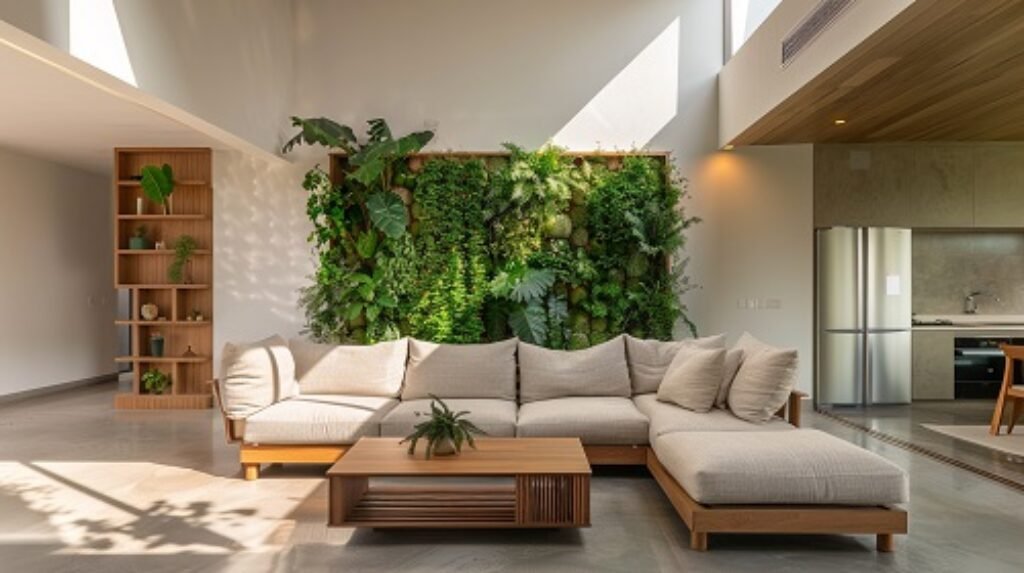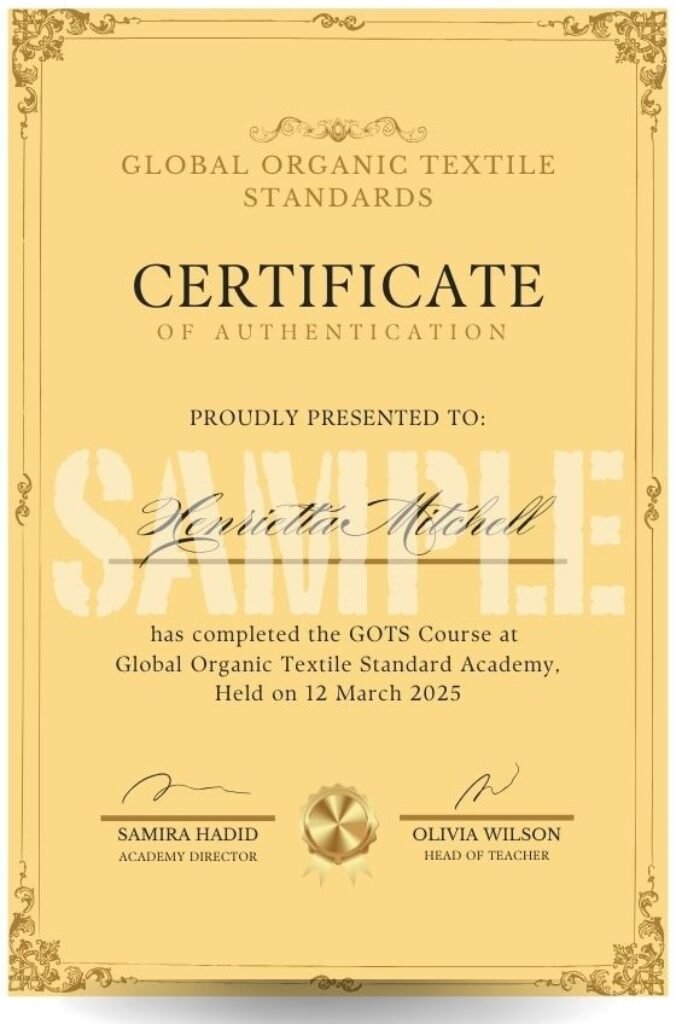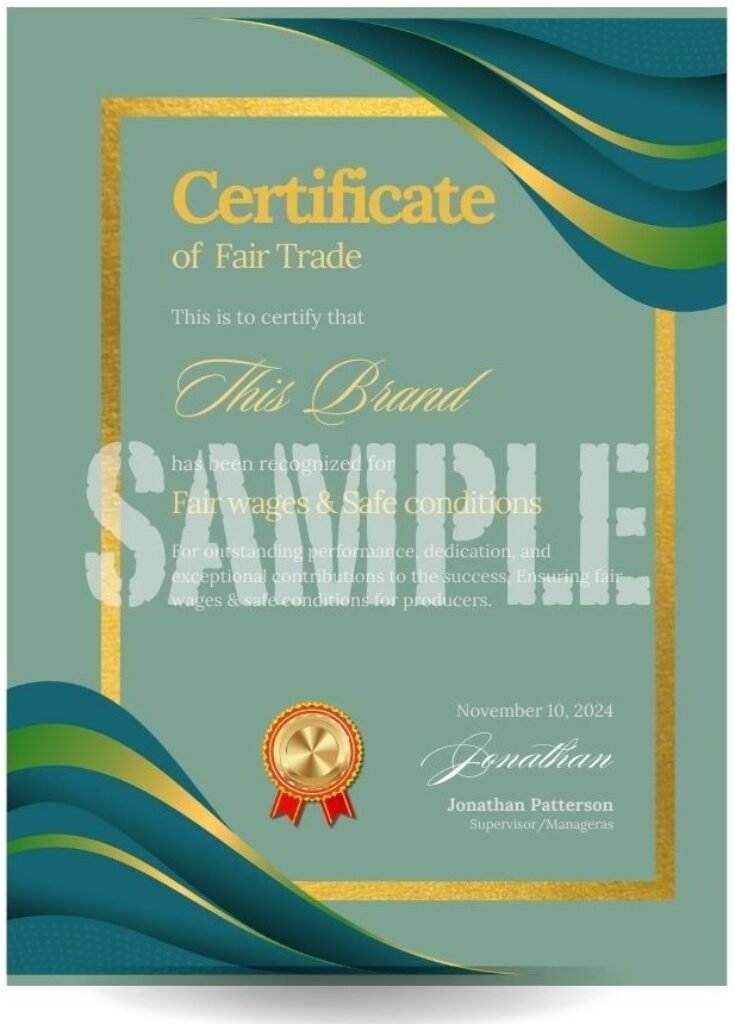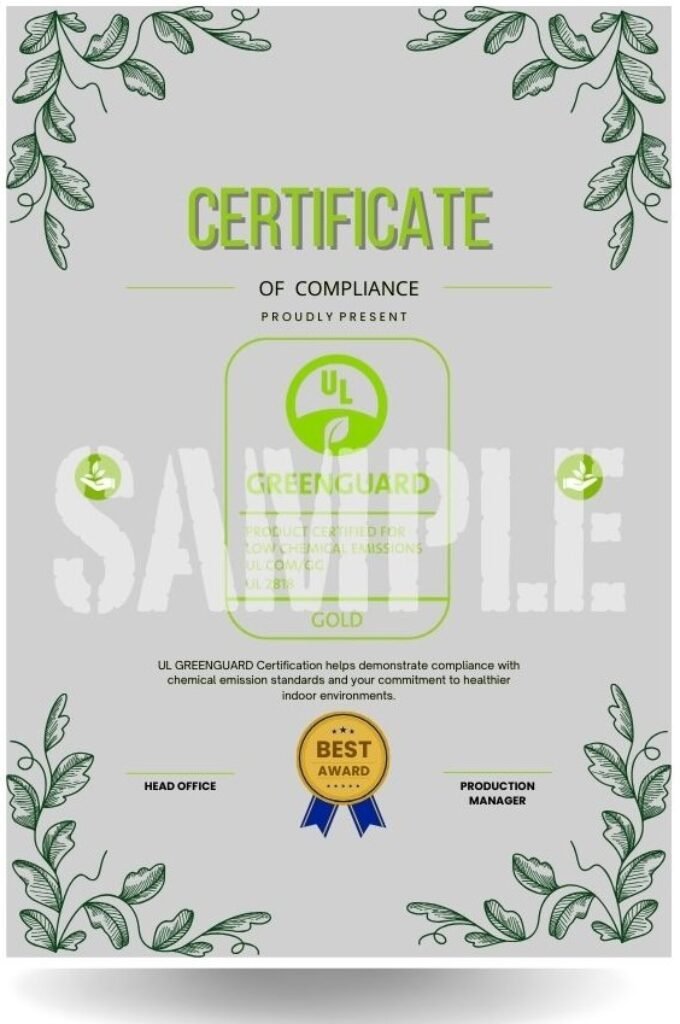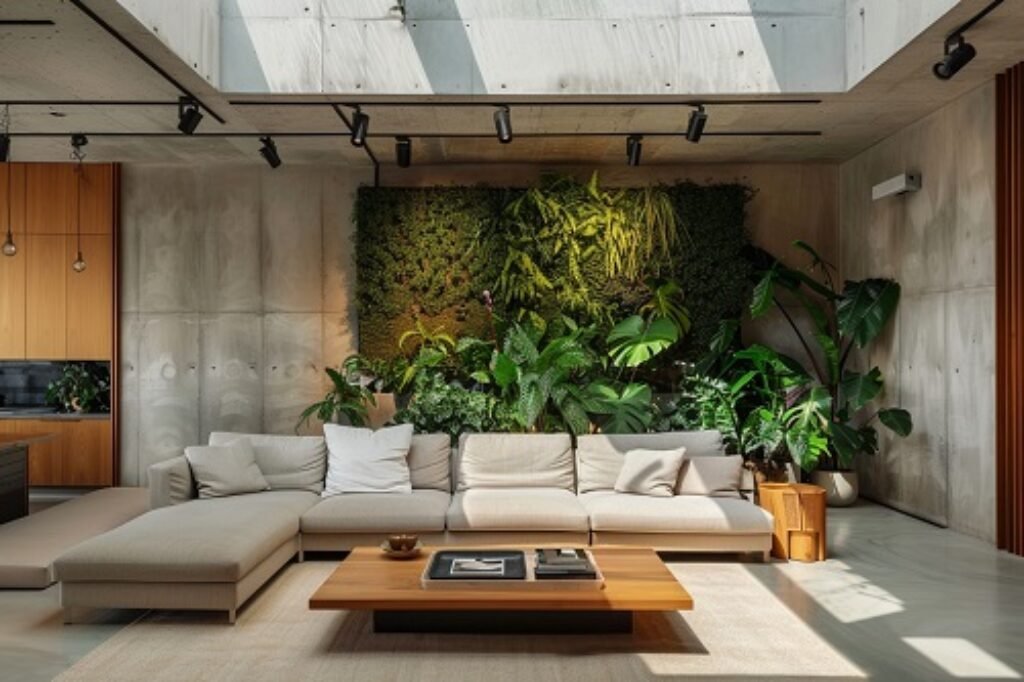
Introduction:
In an era where conscious consumerism is no longer a niche trend but a powerful movement, how we adorn our living spaces is undergoing a beautiful and profound transformation. We’re increasingly seeking more than just style; we crave substance, sustainability, and a connection to the natural world within our own four walls. This shift is giving rise to the incredible popularity of eco-friendly home décor items, proving that you don’t have to sacrifice aesthetics for ethics.
So, what exactly is “eco-friendly home décor”? At its heart, it refers to items crafted with minimal negative impact on the environment. This encompasses everything from the sourcing of raw materials (think renewable, recycled, or reclaimed) and the energy consumed in production, to the item’s lifespan and eventual disposal (biodegradability or recyclability). It’s about choosing pieces that are kind to the planet, safe for our homes, and often, supportive of fair labor practices.
But why are these items suddenly so popular? It’s a confluence of factors: a growing awareness of environmental issues, a desire for healthier living environments free from harmful chemicals, and a genuine appreciation for the unique beauty and craftsmanship often found in sustainable pieces. These aren’t just “green” alternatives; they are often the most stylish, durable, and soul-satisfying choices on the market. This guide will explore the most sought-after eco-friendly décor items, delve into their sustainable qualities, and provide actionable tips for creating a stylish and earth-kind home. Prepare to be inspired, gain invaluable knowledge, and take practical steps towards a home that truly reflects your values.
Why Embrace Eco-Friendly Home Décor? The Compelling Benefits
Choosing eco-friendly home décor isn’t just a fleeting trend; it’s a conscious decision that brings a multitude of benefits, transforming not only our living spaces but also our impact on the world. Let’s explore why making sustainable choices for your home is so compelling:
- Healthier Living Spaces: Conventional home furnishings can often be sources of indoor air pollution, off-gassing Volatile Organic Compounds (VOCs) from paints, finishes, adhesives, and synthetic fabrics. These VOCs can contribute to respiratory issues, allergies, and headaches. Eco-friendly décor prioritizes natural, non-toxic materials, leading to significantly improved indoor air quality and a healthier environment for you and your family. Think breathable natural fibres, zero-VOC paints, and solid wood furniture without formaldehyde-laden glues.
Benefits
- Protecting Our Planet: This is perhaps the most obvious benefit. Eco-friendly décor focuses on:
- Sustainable Sourcing: Utilizing renewable materials (like bamboo or cork), recycled (like glass or metal), or reclaimed (like old wood). This reduces the demand for virgin resources and minimizes habitat destruction.
- Reduced Carbon Footprint: Often, sustainable production methods are less energy-intensive. Sourcing locally or choosing items with minimal packaging also cuts down on transportation emissions.
- Minimizing Waste: Eco-friendly items are often designed for durability, and many are biodegradable or recyclable at the end of their life, diverting waste from overflowing landfills.
- Supporting Ethical & Fair Practices: The eco-friendly ethos often extends beyond environmental concerns to social responsibility. Many sustainable brands are committed to:
- Fair Labor: Ensuring fair wages, safe working conditions, and no child labor in their supply chains. Certifications like Fair Trade can help identify these brands.
- Artisan Support: Promoting traditional crafts and providing livelihoods for artisans in communities around the world. Choosing handmade items often supports these skilled individuals directly.
- Long-Term Value & Durability: While some eco-friendly items might have a higher upfront cost, they often represent better long-term value.
- Quality Craftsmanship: Sustainable items are frequently made with greater care and higher-quality materials than their mass-produced counterparts, meaning they last longer.
- Timeless Appeal: Natural materials and classic designs often have a timeless appeal that outlasts fleeting trends associated with “fast furniture,” reducing the need for frequent replacements.
Embracing eco-friendly home decor is an investment in your health, the planet’s future, ethical production, and enduring style. It’s about creating a home that not only looks good but feels good, in every sense of the word.
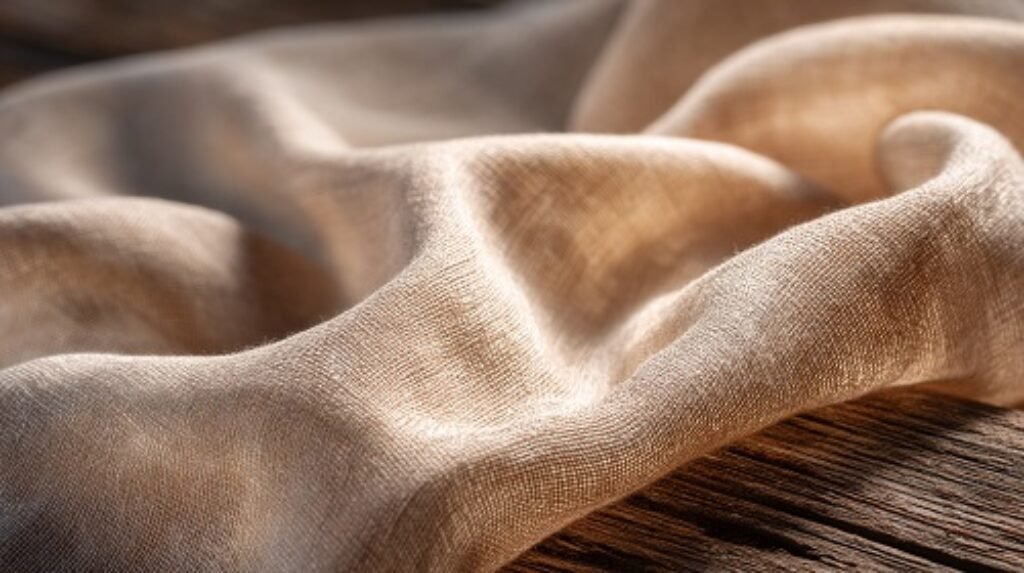

Healthier Living
Non-toxic materials, improved air quality.

Protecting Planet
Sustainable resources, less waste.

Ethical Practices
Fair labor supports artisans.

Long-Term Value
Durable quality, timeless appeal.
Unveiling the Stars: The Most Popular Eco-Friendly Home Décor Items
The world of eco-friendly home décor is vast and exciting. Certain items, however, consistently rise to the top, beloved for their sustainable credentials, aesthetic versatility, and ability to transform a space. Let’s meet these popular stars:
1. Indoor Plants & Sustainable Planters: Breathing Life into Homes
What They Are: Living greenery, from small succulents to statement fiddle-leaf figs, housed in pots made from earth-friendly materials.
Key Eco-Friendly Materials/Aspects:
- Plants: Natural air purifiers, absorb CO2 and release oxygen, and enhance humidity.
- Planters: Terracotta (natural clay, breathable), ceramic (look for locally made, non-toxic glazes), recycled plastic or composite materials, sustainably sourced wood (FSC-certified), cork, woven natural fibers (seagrass, jute).
Why They’re Popular: The biophilia trend (our innate desire to connect with nature) is booming. Plants instantly add life, color, and texture to any room. They are relatively affordable, cater to various care levels, and contribute to a sense of calm and well-being. Sustainable planters ensure that even the containers reflect an eco-conscious choice.
Examples/Styling Ideas: A collection of small cacti and succulents on a windowsill in terracotta pots. A large snake plant in a minimalist recycled plastic planter in a living room corner. Hanging pothos in a macrame hanger with a sustainably sourced wooden pot.
Things to Look For When Buying: For plants, consider your light conditions and care ability. For planters, check the material composition, look for drainage holes, and ensure the size is appropriate for the plant. Seek out local nurseries or growers to reduce the transport footprint.
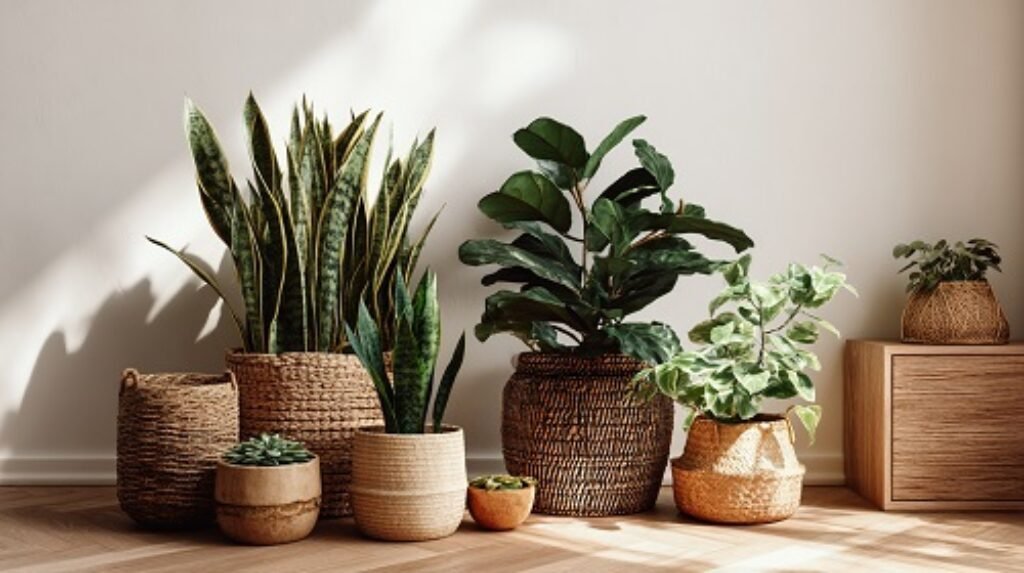
2. Sustainable Textiles: Cozying Up Consciously (Rugs, Curtains, Throws, Bedding)
What They Are: Fabrics used for home furnishings made from natural, organic, or recycled fibers, processed with minimal environmental impact.
Key Eco-Friendly Materials/Aspects:
- Organic Cotton: Grown without synthetic pesticides or fertilizers (look for GOTS certification).
- Linen: Made from flax, it requires less water and pesticides than cotton, is biodegradable, and very durable.
- Hemp: Highly durable, requires minimal water and no pesticides, excellent for upholstery and rugs.
- Jute & Sisal: Natural plant fibers, biodegradable, strong, often used for rugs and baskets.
- Recycled Fibers: rPET (from plastic bottles), recycled cotton or wool, reducing landfill waste.
- Low-Impact Dyes: Natural dyes or synthetic dyes with reduced water and chemical use.
Why They’re Popular: Textiles offer an immediate and impactful way to change the look and feel of a room. They add warmth, texture, color, and comfort. The growing awareness of chemicals in conventional textiles (dyes, finishes) makes sustainable options highly desirable for health-conscious consumers.
Examples/Styling Ideas: A chunky jute rug anchoring a living room seating area. Breezy organic linen curtains diffusing sunlight. A cozy recycled wool throw is draped over a sofa. GOTS-certified organic cotton bedding for a healthy night’s sleep.
Things to Look For When Buying: Certifications like GOTS, Oeko-Tex Standard 100 (tests for harmful substances). Transparency about fiber origin and dyeing processes. Durability and care instructions.
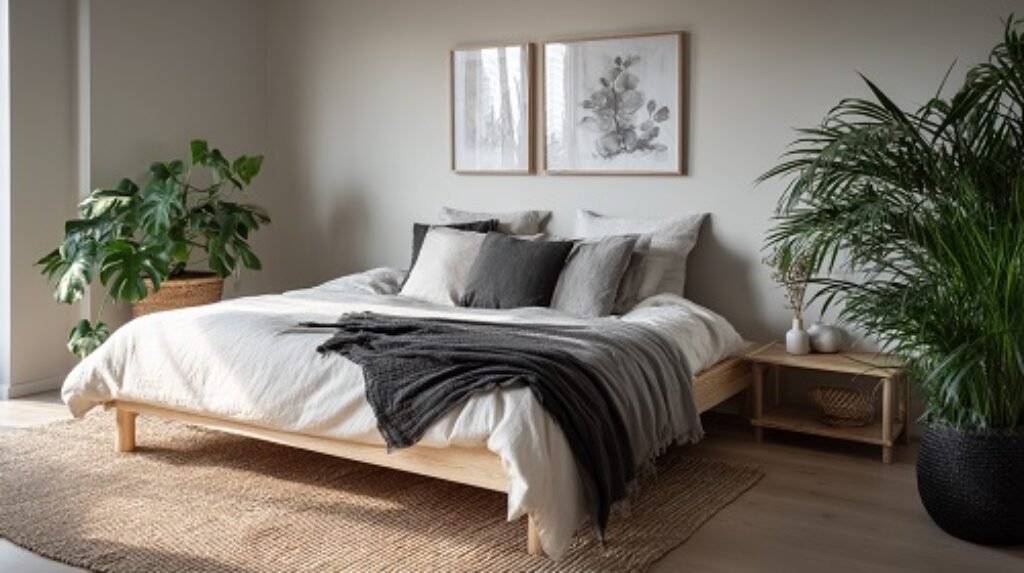
3. Reclaimed & FSC-Certified Wood Furniture: Character with a Conscience
What It Is: Furniture pieces crafted from wood that has been salvaged from old buildings, barns, or ships (reclaimed), or sourced from forests managed responsibly (FSC-certified).
Key Eco-Friendly Materials/Aspects:
- Reclaimed Wood: Diverts usable wood from landfills, reduces the need to fell new trees, and often possesses unique character and history.
- FSC-Certified Wood: Guarantees that the wood comes from forests managed to maintain biodiversity, ecological processes, and protect workers’ rights.
- Low-VOC Finishes: Using natural oils, waxes, or water-based stains instead of chemical-laden varnishes.
Why It’s Popular: Reclaimed wood offers unparalleled character—knots, nail holes, and grain patterns tell a story, making each piece unique. FSC-certified wood provides peace of mind about responsible forestry. Both options appeal to those seeking durable, high-quality furniture with a rustic, industrial, or modern-farmhouse aesthetic. They are often seen as investment pieces.
Examples/Styling Ideas: A dining table made from reclaimed barnwood. A bookshelf constructed from FSC-certified oak. A coffee table with a live-edge reclaimed slab top.
Things to Look For When Buying: For reclaimed wood, ask about its origin and how it was treated. Look for solid construction. For FSC-certified wood, verify the certification (check the FSC database if unsure). Inquire about the finishes used.

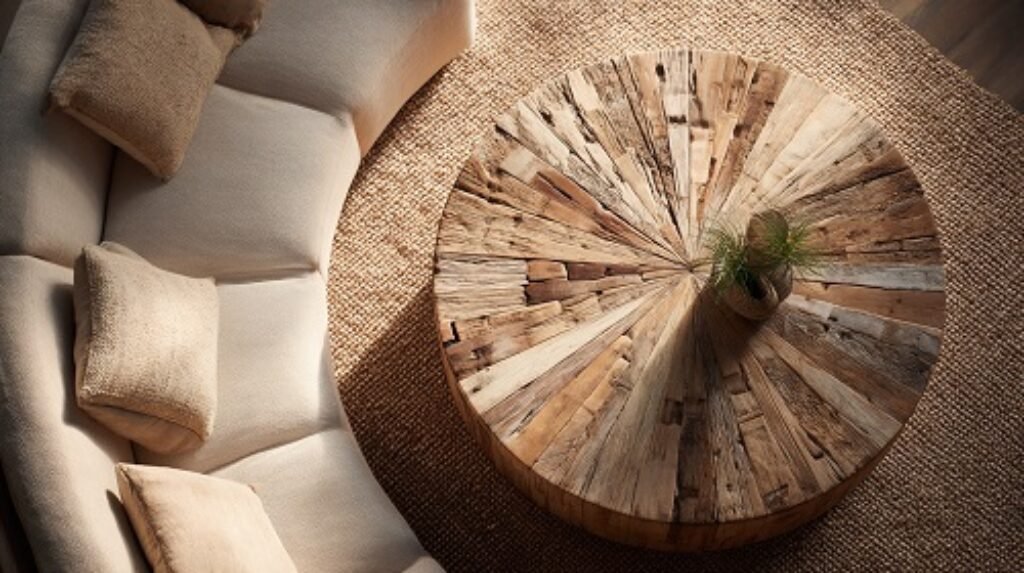
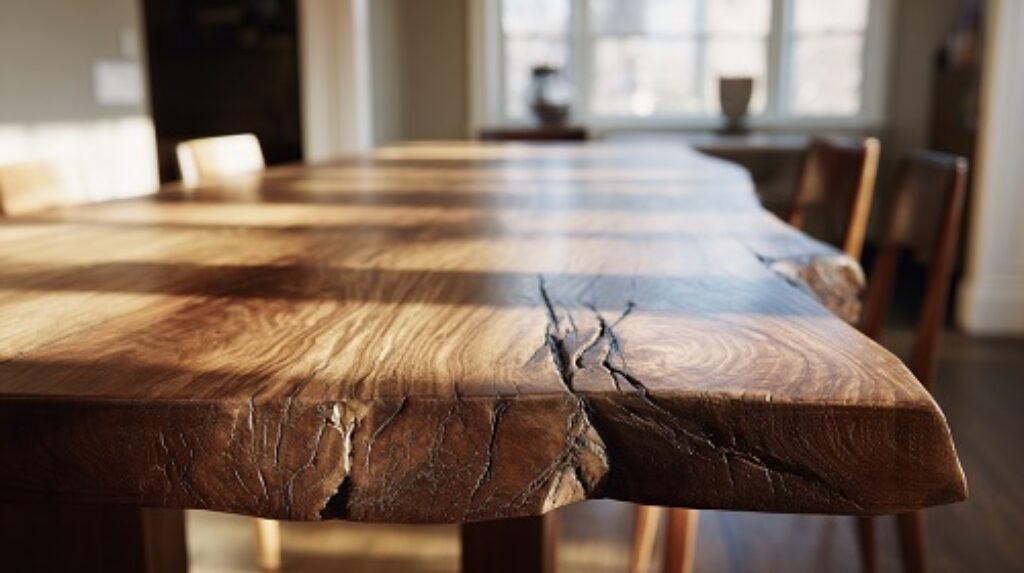
4. Bamboo Décor & Furnishings: The Fast-Growing Favourite
What It Is: Items made from bamboo, a type of grass known for its rapid growth and strength.
Key Eco-Friendly Materials/Aspects:
- Rapidly Renewable: Bamboo can mature in 3-5 years, significantly faster than hardwood trees.
- Strength & Durability: Comparable to many hardwoods.
- Minimal Inputs: Generally requires less water, no pesticides, or fertilizers to grow.
- Carbon Sequestration: Absorbs more CO2 and releases more oxygen than comparable tree species.
Why It’s Popular: Bamboo’s versatility is a huge draw. It can be used for everything from flooring and furniture to kitchenware, blinds, and decorative accents. Its light, modern aesthetic fits well with minimalist and Scandinavian designs. It’s often more affordable than traditional hardwoods.
Examples/Styling Ideas: Bamboo bathroom accessories (soap dispensers, trays), woven bamboo pendant lights, bamboo cutting boards and utensils, sleek bamboo shelving units or side tables, and bamboo window blinds.
Things to Look For When Buying: Look for products made from solid bamboo rather than bamboo composite that might use formaldehyde-based adhesives. Inquire about the source of the bamboo and manufacturing processes. Moso bamboo is often cited as a particularly sustainable species.
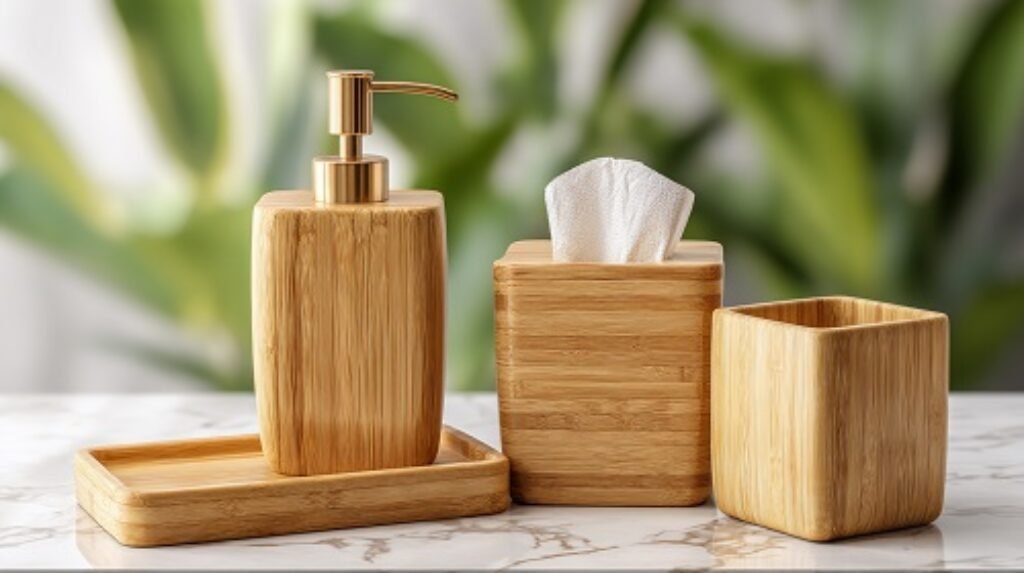



5. LED Lighting & Eco-Conscious Fixtures: Illuminating Sustainably
What They Are: Light Emitting Diode (LED) bulbs, which are highly energy-efficient, and light fixtures made from sustainable or recycled materials.
Key Eco-Friendly Materials/Aspects:
- LED Bulbs: Use up to 75-80% less energy than incandescent bulbs and last up to 25 times longer, significantly reducing electricity consumption and waste.
- Fixtures: Made from materials like FSC-certified wood, bamboo, rattan, recycled glass, recycled metal, or natural stone.
Why They’re Popular: The energy and cost savings of LED bulbs are undeniable. They also offer better light quality and come in various color temperatures. Eco-conscious fixtures are gaining popularity as people seek to extend their sustainable choices to every element of their decor, and designers are creating stunning pieces with these materials.
Examples/Styling Ideas: Replacing all incandescent bulbs with LED equivalents. A pendant light with a woven rattan or bamboo shade over a dining table. A table lamp with a base made from recycled glass or sustainably sourced wood.
Things to Look For When Buying: For LEDs, check lumens (brightness) and Kelvin (color temperature) to suit your needs. Look for Energy Star certification. For fixtures, verify the material sources and ensure the style complements your decor.
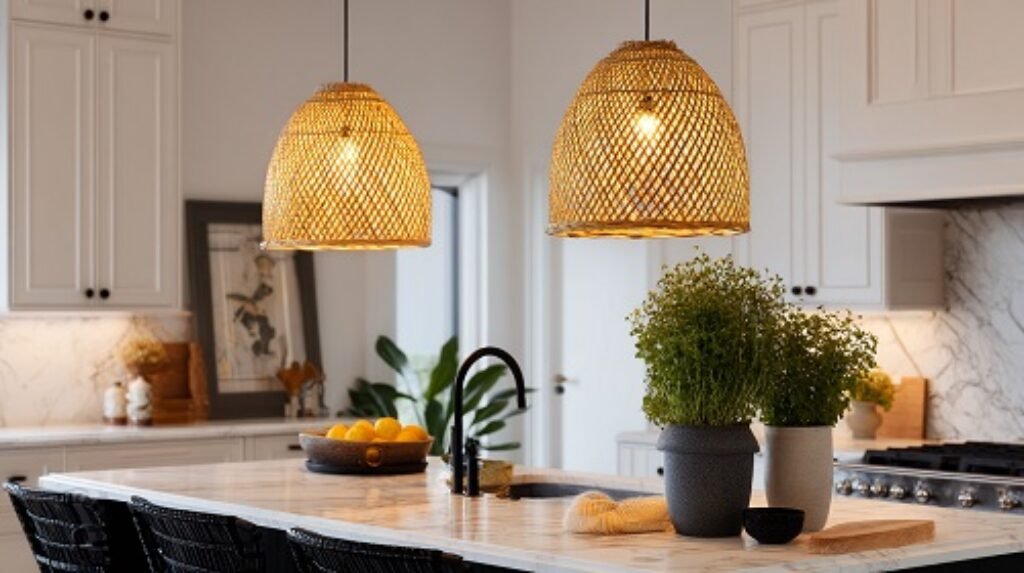
6. Non-Toxic Paints & Wall Coverings: Walls That Nurture
What They Are: Wall treatments that minimize or eliminate harmful chemicals, creating healthier indoor air.
Key Eco-Friendly Materials/Aspects:
- Low-VOC or Zero-VOC Paints: Contain fewer or no volatile organic compounds, which can off-gas for years.
- Natural Paints: Made from plant-based oils, milk protein (casein), or natural minerals like clay or lime. Biodegradable and breathable.
- Sustainable Wallpapers: Made from recycled paper, FSC-certified paper, grasscloth, cork, or printed with water-based inks.
- Other Wall Coverings: Reclaimed wood paneling, cork tiles, natural plasters (clay, lime).
Why They’re Popular: Increased awareness of indoor air quality and the health impacts of conventional paints (headaches, respiratory issues) has fueled demand for non-toxic alternatives. These options also offer unique textures and finishes that can’t be achieved with standard paints, appealing to design-savvy consumers.
Examples/Styling Ideas: Painting a nursery with zero-VOC paint. Creating a feature wall with textured clay paint or lime wash. Use grasscloth wallpaper for a sophisticated, natural look. Installing cork tiles for added warmth and sound insulation.
Things to Look For When Buying: Check labels carefully for VOC content. Look for certifications like Greenguard Gold. Research brands known for their commitment to natural and non-toxic formulations. For wallpapers, ask about the paper source and inks used.

7. Upcycled & Recycled Material Accents: Uniquely Green
What They Are: Decorative items crafted from materials that have been given a new life, either through creative reuse (upcycling) or reprocessing (recycling).
Key Eco-Friendly Materials/Aspects:
- Waste Diversion: Keeps materials out of landfills.
- Reduced Need for Virgin Resources: Conserves natural resources by utilizing existing materials.
- Creativity & Innovation: Often results in unique, one-of-a-kind pieces.
Why They’re Popular: These items embody resourcefulness and creativity. They are often conversation starters and allow individuals to express their unique style while making a strong environmental statement. The rise of DIY culture and appreciation for artisanal goods has also boosted their popularity.
Examples/Styling Ideas: Vases made from recycled glass bottles. Decorative bowls crafted from melted-down recycled plastics. Cushions sewn from vintage fabric scraps or old clothing. Wall art created from repurposed metal or wood.
Things to Look For When Buying: Look for quality craftsmanship. Understand the story behind the materials, if possible. Support artisans and small businesses specializing in upcycled/recycled goods. Consider DIY projects to create your unique pieces.

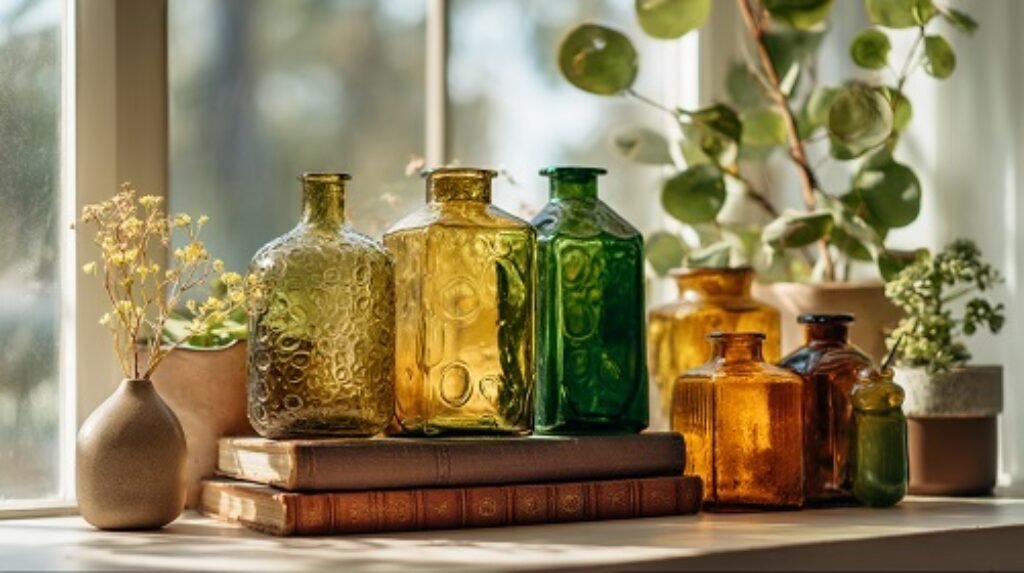
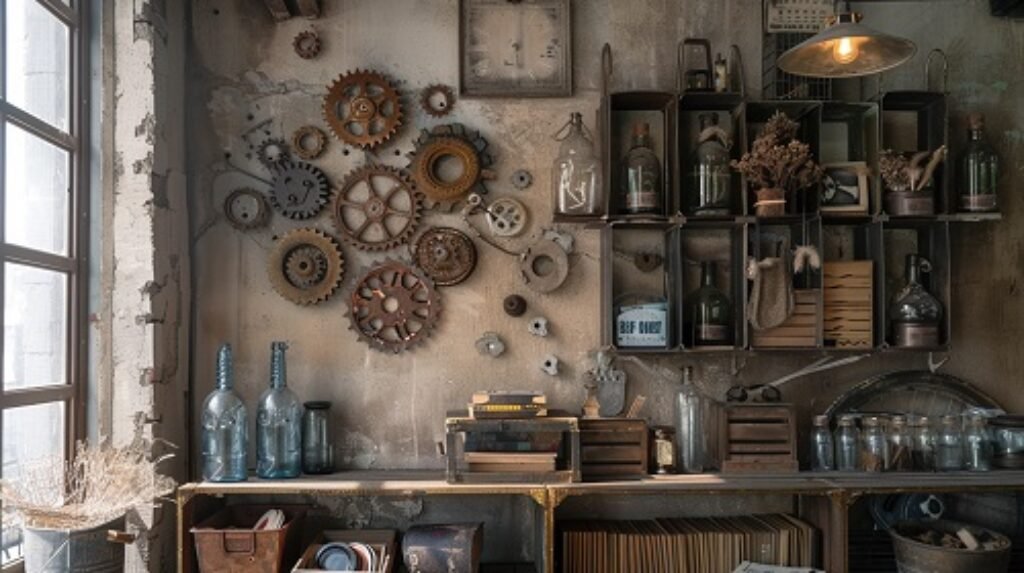
8. Cork Creations: The Sustainable & Versatile Wonder Material
What It Is: Products made from the bark of the cork oak tree, a remarkably sustainable and versatile natural material.
Key Eco-Friendly Materials/Aspects:
- Harvesting Process: Cork bark is harvested without harming the tree, which continues to live and regrow its bark every 9-12 years. This makes it a truly renewable resource.
- Biodegradable & Recyclable: Cork is fully biodegradable and can be easily recycled.
- Natural Properties: It’s lightweight, water-resistant, fire-retardant, insulating (both thermal and acoustic), and hypoallergenic.
Why It’s Popular: Cork’s unique combination of eco-credentials and practical benefits makes it highly attractive. Its warm, natural texture adds a distinct aesthetic to interiors. It’s increasingly being recognized beyond wine stoppers for its wide range of applications in home decor.
Examples/Styling Ideas: Cork flooring for a warm, comfortable, and quiet surface. Cork wall tiles or panels for insulation and visual interest. Placemats, coasters, and trivets in the kitchen. Cork notice boards for home offices. Even some furniture pieces incorporate cork elements.
Things to Look For When Buying: Look for solid cork products or those using water-based, formaldehyde-free adhesives if it’s a composite. Inquire about the origin if possible (Portugal is a major producer with well-managed cork forests).

9. Consciously Crafted Ceramics & Glassware: Artisan Touches
What They Are: Tableware, vases, and decorative objects made from clay or glass, with an emphasis on sustainable practices and often artisanal production.
Key Eco-Friendly Materials/Aspects:
- Natural Materials: Clay and sand (for glass) are abundant natural resources.
- Local Sourcing: Many artisans source clay locally, reducing transportation impacts.
- Small-Batch Production: Often results in less waste compared to mass manufacturing.
- Lead-Free Glazes & Recycled Glass: Prioritizing non-toxic finishes and using recycled content to reduce virgin material use.
- Durability: Well-made ceramics and glassware can last for generations.
Why They’re Popular: There’s a growing appreciation for handmade, unique items that tell a story. Consciously crafted ceramics and glassware bring an element of artistry and individuality to the home. Supporting local artisans and small businesses is also a significant draw for many consumers. These items are both functional and beautiful.
Examples/Styling Ideas: Hand-thrown pottery mugs and bowls for daily use. Vases made from recycled glass showcase interesting textures and colors. Unique ceramic sculptures or decorative tiles.
Things to Look For When Buying: Look for information about the artist or maker. Ask about the materials used (e.g., type of clay, recycled glass content) and glazing processes (ensure they are food-safe and lead-free for tableware). Consider purchasing directly from artisans or at local craft markets.

Smart Shopping: How to Choose Genuinely Eco-Friendly Home Decor
Navigating the world of eco-friendly products can sometimes feel overwhelming, with terms like “natural,” “green,” and “sustainable” used loosely. To ensure you’re making genuinely earth-kind choices, here’s how to shop smart:

Decode the Labels: Understanding Certifications
Certifications provide third-party verification of a product’s eco-credentials. Look for:
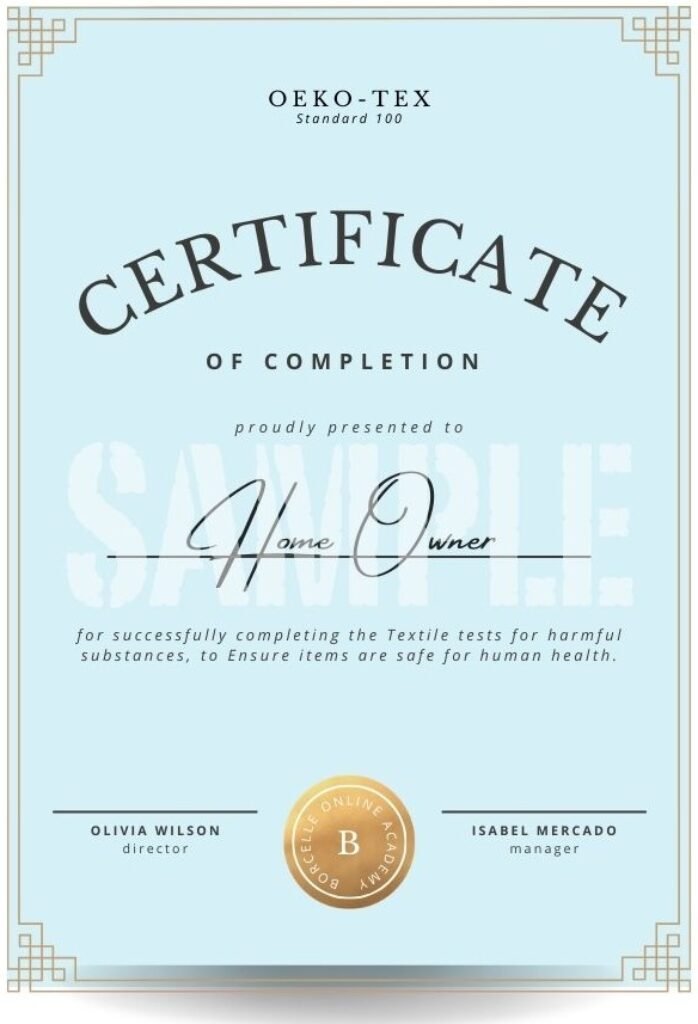
Oeko-Tex Standard 100
Tests textiles for harmful substances. Ensures items are safe for human health.
Discover more ideas with our Home Improvement Resources

